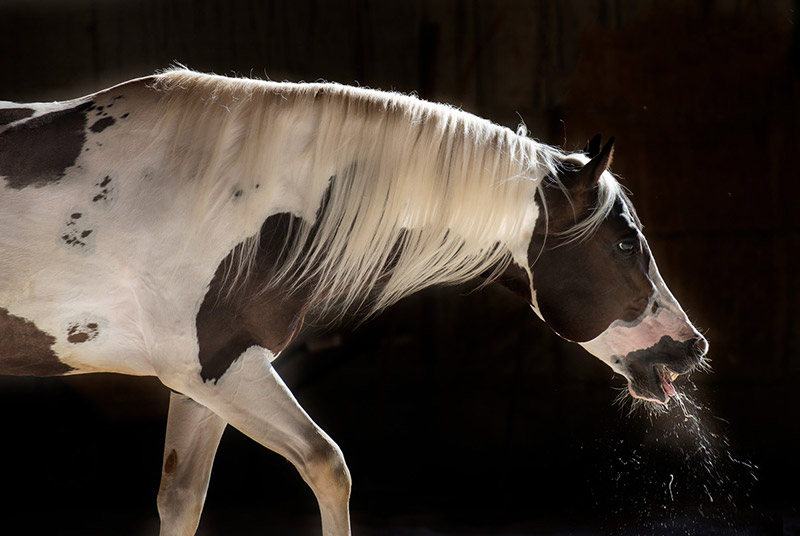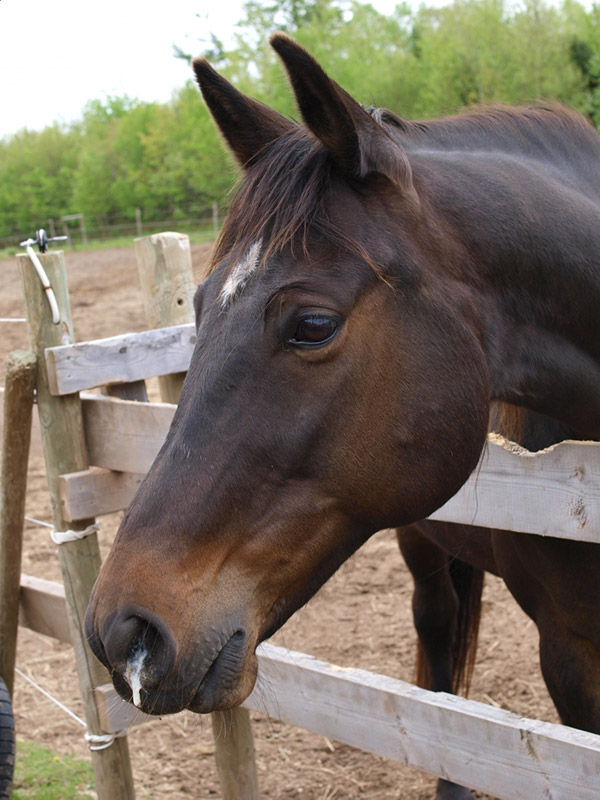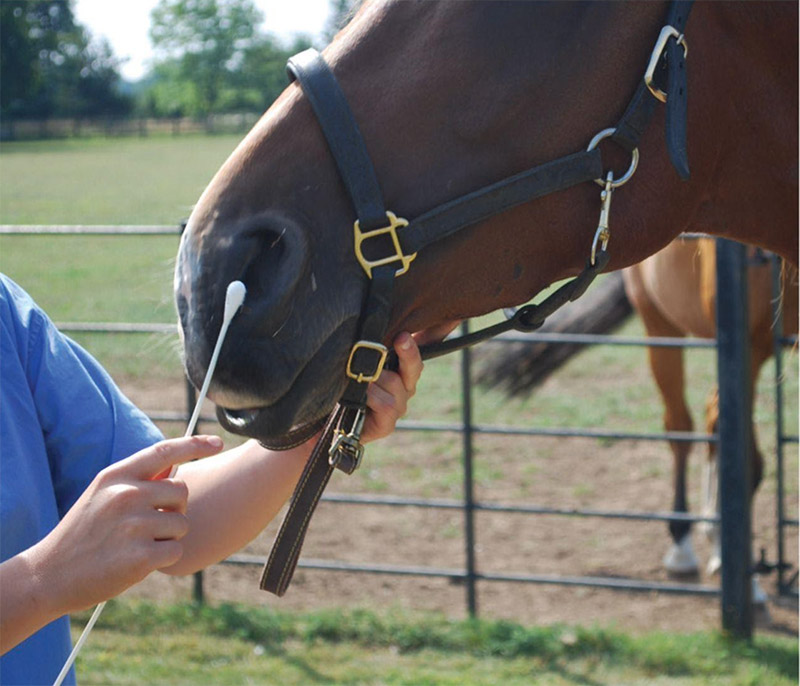Section 1 | Respiratory Diseases in Horses: Streptococcus equi
Industry
Page 03 /
A Note on Respiratory Disease in Horses
This FAAST Review aims to educate the industry on best management practices to prevent transmission of bacterial respiratory disease that may require the use of antimicrobial medications as directed by your veterinarian.
In the interest of improving antimicrobial stewardship in the Ontario equine sector, it is important to note that the majority of respiratory disease (diseases that affect the upper airway and/or lungs) of horses are caused by viruses. Viruses do not respond to treatment with antimicrobial medications. This is inappropriate use of antimicrobial medications, and inappropriate use can contribute to the development of antimicrobial resistance, rendering the antimicrobial medications that are available for use in horses ineffective. For more information, check out our page called How Antimicrobials Work and When to Use Them.
The most common viruses that cause respiratory disease in horses include:
)
Equine Influenza A
Equine influenza, or horse flu is a highly contagious viral disease that commonly infects young animals that either have not exposed or are not vaccinated against it.
Clinical Signs
Clinical signs of horse flu include:
- Fever, where temperature is >38.5°C or >101.3°F
- Nasal discharge
- Swelling of submandibular (under the jaw) lymph nodes
- Dry cough
- Depression
- Loss of appetite
- Weakness

Source: EquiManagement
Diagnosis
Diagnosis is often made by nasopharyngeal swabs to isolate the virus and differentiate from bacterial disease. Antigen test kits paired with blood testing is also a common way to diagnose the virus.
Treatment
The main treatment for horses affected by influenza is rest and supportive care (fresh, palatable feed, clean water, warm, dry, clean stall, etc.) Nonsteroidal anti-inflammatory medications may be recommended by your veterinarian to help bring down fever associated with influenza. Antimicrobial use will not treat influenza unless damage of the respiratory tract has allowed bacterial entry into deeper lung tissue causing pneumonia. Treating this viral disease with medications used to kill bacterial is ineffective and is not prudent use of antimicrobial medications.
Prevention
An important factor in prevention of equine influenza is implementing a vaccine strategy based on advice and recommendations from your veterinarian. Newly introduced horses to a facility should be isolated for at least 2 weeks and monitored closely for signs of disease.
Equine Rhinitis A Virus
Equine rhinitis virus causing mild disease in both the upper and lower respiratory tract. Infected animals typically show signs for about 1 week.
Clinical Signs
Common symptoms of equine rhinitis include:
- Fever, where temperature is >38.5°C or >101.3°F
- Nasal discharge
- Coughing
- Abnormal lung sounds on auscultation (listening with a stethescope)
- Loss of appetite
- Pharyngitis (inflammation of the pharynx, or the back of the throat)
- Swelling of lymph nodes

Source: Paulick Report
Treatment
Because disease is typically mild, no treatment is typically required. The use of a nonsteroidal anti-inflammatory medication may be necessary to reduce fever in some animals. Use these according to your veterinarian’s instruction!
As with most viral diseases, antimicrobials are not effective in treating infection. This represents a significant source of misuse which could contribute to antimicrobial resistance!
Diagnosis
Diagnosis of rhinitis is made by collecting specimens through the use of nasopharyngeal swabs, and can be found in urine, feces, and blood samples. More advanced laboratory testing can be performed on blood samples.
Prevention
Like most respiratory diseases that will be discussed, isolating new animals into entering a facility and monitoring them for signs of disease is important to prevent the spread of disease to a resident herd. These animals should not have contact with other animals either in the barn or on pasture or paddocks. Use designated cleaning and feeding equipment and keep the barn appropriately stocked and well-ventilated to reduce the number of pathogens in the air.
There are no vaccines available for use against equine rhinitis in Canada — prevention using good biosecurity and hygiene practices are key!
Equine Herpesvirus
Equine herpesvirus 1 and 4 are significant causes of respiratory disease in horses. Transmission occurs from both direct and indirect contact, where nasal secretions and contact with infected aborted fetuses, placentas, or fluids containing infectious material that can be transmitted to other animals.
Infection depends on the immune status of the animals — foals, as well as pregnant and older animals seem to be more severely affected. Animals with previous exposure or that have been vaccinated develop good immunity.
Clinical Signs
Symptoms of these strains of herpesvirus include:
- Fever, where temperature is >38.5°C or >101.3°F
- Nasal discharge
- Depression
- Pharyngitis (inflammation of the pharynx, or back of the throat)
- Coughing
- Swollen lymph nodes
- Loss of appetite
- In more severe cases, the nervous system may be involved where hind end paralysis may occur
Because this virus can cause damage to the airways, an infected horse may be susceptible to bacterial invasion. When these bacteria reach the animal’s lungs, pneumonia can develop.
Diagnosis
Because of the similarity of equine respiratory diseases in their clinical symptoms, diagnosis cannot be made solely on these factors. If you suspect a horse has developed a respiratory infection, call your veterinarian. They can perform the necessary nasopharyngeal swabs and blood testing to differentiate the pathogen that is present.

Source: Veterinary Record
Treatment
There are no specific medications available to treat viral infections. Good nursing and supportive care (providing horses with good feed, clean water, a clean, warm, and dry stall, and rest) can help with recovery. Using an NSAID medication may help to reduce fevers associated with respiratory infections.
Treatment with antimicrobial medications is only warranted when viral infections advance to cause pneumonia. Discuss treatment protocols with your veterinarian and ensure that testing and differentiation supports the use of antimicrobials! Treating viral disease with antimicrobial medications is ineffective and can contribute to antimicrobial resistance. It is important to use the medications we have available to us appropriately to ensure their continued effectiveness.
Prevention
Vaccines are available for animals of different ages and stages of production. Work with your veterinarian to develop a strategy to maintain high levels of immunity in the herd.
As mentioned, broodmares can be a source of infection from placenta and other fluids; ensure the barn is clean, appropriately stocked, and that potential infective materials and secretions are removed promptly. Designated equipment should be used for these materials and disinfected after use to prevent the spread of viral material to other animals.
Take Home Message
As mentioned, respiratory diseases of horses present very similarly. If you suspect that an animal is displaying symptoms of a respiratory infection, contact your veterinarian immediately. They can perform the necessary testing to differentiate between a viral and bacterial respiratory infection. This is prudent in developing an appropriate treatment protocol to ensure effectiveness and best use of resources.
Your veterinarian can also help you to develop a vaccine strategy that will help to reduce the incidence of disease in the barn, and protect horses from developing disease if they are in contact with other animals within a facility or while travelling.
For more information on proper antimicrobial use, check out our FAAST Review, Antimicrobial Stewardship